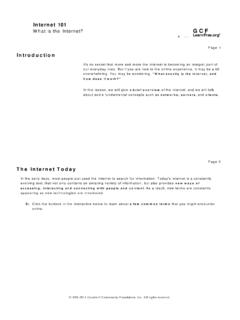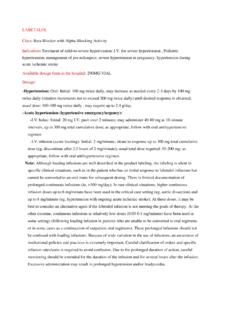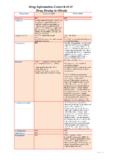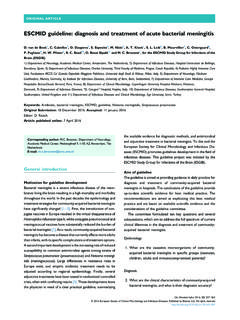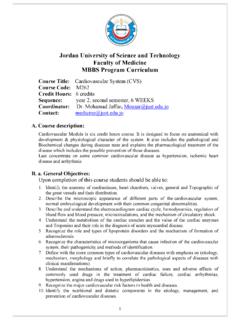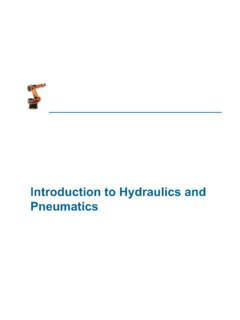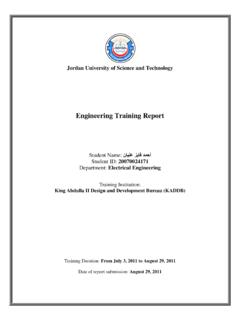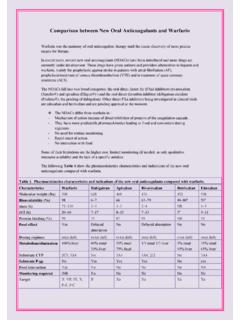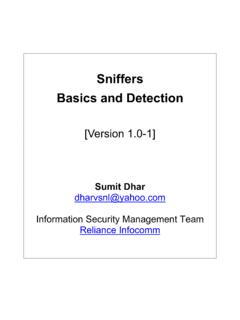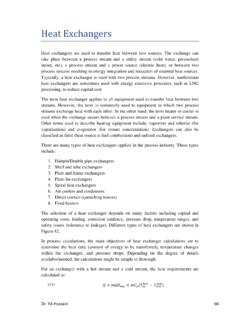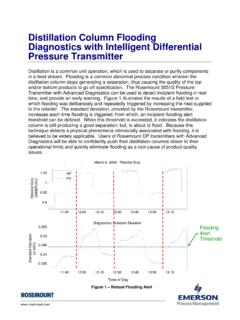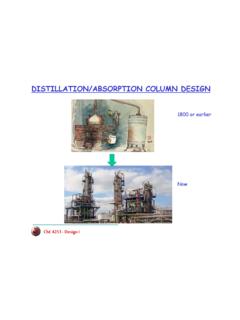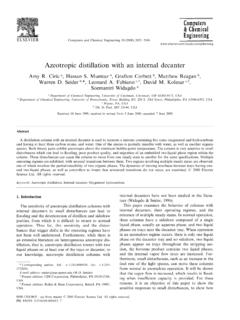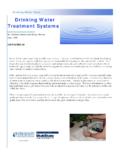Transcription of Equilibrium Separation Column
1 Dr. YA Hussain 108 Equilibrium Separation Column In Equilibrium Separation processes, two or more coexisting zones are created with preferential distribution of the different components involved in the process in each zone. For example, in distillation a liquid and vapor zones are created and the components are separated in different proportions between these zones. In absorption and stripping, liquid and gas phases are created. In extraction, two liquid phases are created. The zones are assumed to be, as the name implies, in Equilibrium with each other. This means that the temperature, pressure, and phase compositions are all in thermodynamic Equilibrium . Thus, while all Separation processes are essentially a mass transfer process, the Equilibrium assumption cancels out the need for dealing with transfer rates and focuses only on the transfer amounts.
2 Equilibrium Separation processes are usually operated in a counter current configuration in which the two zones are made to flow opposite to each other in a closed vessel (or Column ). To ensure good contact, the Column is either equipped with trays or filled with packing. In both cases, the contact process can be viewed as a stagewise process in which the two zones are contacted thoroughly in each stage and leaves at Equilibrium . Each zone then proceeds to a different stage where it is contacted again to leave at Equilibrium , and so on. The counter current configuration provides better driving force for transfer than co-current configuration. A schematic representation of typical (general) Column used for Equilibrium Separation is shown in Figure 74.
3 In this diagram, the material to be separated (F) is fed to the Column (more than one feed can be employed). Depending on the feed state, it will either start to rise towards the top of the Column or fall towards the bottom. At the top of the Column , a condenser can be used to condense part or all of the vapors that leave the top. This is called the overhead condenser. Part (and sometimes all) of the condensed liquids are returned to the Column as a reflux. The reflux then combines with any liquid feed at the top of the Column and flows down. The remaining part of the condensate is taken as a distillate or overhead product. Liquids flow down the Column , contacting the vapors as they rise, to the bottom where it can be partially vaporized in the reboiler.
4 The reboiler heats the fluids and boils up the ReboilerOverheadCondenserBoil-upBottomsD istillateFeedReflux12nN 1 NQcQb Figure 74. Simple, continuous distillation Column 109 liquid which partially evaporates. The vapors (or boil-up) are returned to the Column , and a bottom product, or bottoms, are drawn as a liquid. As mentioned earlier, such Separation processes are treated as an Equilibrium system. With this assumption, it is possible to treat a distillation Column using thermodynamic phase Equilibrium relations. The validity of this assumption depends on the ability of each stage to achieve temperature, pressure, and phase Equilibrium . Practical operating considerations impose a limitation on how close Equilibrium is approached.
5 Therefore, a tray efficiency is used to express the deviation from Equilibrium . Using the tray efficiency allows the definition of theoretical and actual stages. A theoretical stage is one that achieves Equilibrium between the phases, while actual stage represents an actual tray in the Column . While the application of the Equilibrium approach and efficiencies had been successfully applied to many Separation systems, a new approach has been developed that takes into account the transfer process between the phases. This approach is referred to as non- Equilibrium (NEQ) or rate-based approach. In this approach, a stage (or tray) can be imagined to be divided into two phases, and material balances are written for the components in each phase.
6 The rate dependence in the material balance arises from the mass transfer of the component from one phase to another. Figure 75. Separation operations related to distillation . (a) Flash vaporization or partial condensation. (b) Absorption. (c) Rectifier. (d) Stripping. (e) Reboiled stripping. (f) Reboiled absorption. (g) Refluxed stripping. (h) Extractive distillation . (i) Azeotropic Dr. YA Hussain 110 The above discussion and the configuration shown in Figure 74 present a distillation process in which the Separation is based on the relative volatility of the components. Other processes related to distillation are shown in Figure 75. In addition to the phases present inside the Column , variations in these processes involves differences in the feed(s), presence or absence of reboiler or condenser, and the use of mass separating agent (MSA).
7 For example, in an absorption Column a liquid stream is fed at the top of the Column while a gas stream is fed from the bottom. The two phases are contacted in the Column before leaving to further processing. No reboiler or condenser are used. Operating Conditions Multistage Separation towers can be operated anywhere the two phases coexist, avoiding the proximity of the critical point. Pressure ranges for operation vary from very low (< 1 psia for vacuum distillation used with temperature sensitive materials) to several hundred (as is the case for absorbers operation). The selection of operating pressure for distillation columns can be roughly estimated based on the distillate bubble point pressure as illustrated in Figure 76.
8 Typical operating pressures in distillation range from 1 to 415 psia. The algorithm suggested in the figure starts by a known or assumed distillate composition and calculates the bubble-point pressure at 50oC. Based on this pressure, the type of condenser is selected and the expected Column operating pressure is designed based on a typical pressure drop inside the Column of 5 10 psi. The temperature of the reboiler is then determined based on dew-point calculations taking into account any limiting temperatures that may be encountered (decomposition, critical, polymerization). distillation Column Design The complete design of a distillation Column requires the determination many parameters such as the feed location, number of trays or Column diameter, trays design or packing type, Separation between trays or packing height, total Column height, and mechanical design.
9 The complete design procedure for columns require the application of rigorous calculations, general rule of thumbs, and previous experience. One of the first design steps required for distillation Column is to determine the number of theoretical stages required and the feed location. 20 Don Green and Robert Perry, Perry s Chemical Engineers' Handbook, Eighth Edition, 8th ed. (McGraw-Hill Professional, 2007). 111 The most rigorous analysis of distillation (and other staged Separation processes) can be made based on a stage-by-stage analysis. This is done by performing components and energy balances on each stage assuming Equilibrium is achieved between the two phases.
10 Consider for example the stage (or tray) shown to the right (take the light phase to be vapor and the heavy phase to be liquid). In this stage, the liquid enters the stage with a flow rate of and composition and leaves with a flow rate and composition of and . A similar convention is used for the vapor with and . A fresh feed can be added to the stage with flow rate of and composition . Side streams ( and ) can be drawn from the vapor and/or liquid streams. The total material balance on this stage is given by: (48) ( ) ( ) where and are the draw ratios. Similarly, a component balance can be written: (49) ( ) ( ) 21 Warren D.
